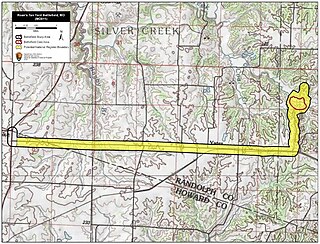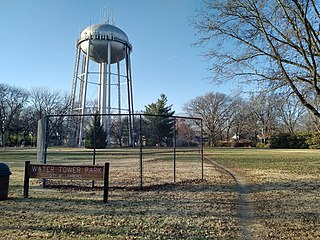
The Battle of Roan's Tan Yard was an action during the American Civil War, occurring on January 8, 1862, in Randolph County, Missouri.
John Mendenhall was an officer in the United States Army. As a Union Army artillery officer in the American Civil War, his performance was notable at the Battle of Stones River, where his concentration of guns broke the last Confederate attack.
On March 7, 1862, Confederate guerrillas under William C. Quantrill raided the small Kansas town of Aubry, southwest of Kansas City, Missouri, and just west of the Kansas-Missouri border. Three residents were killed in the raid and much property was carted away by the guerrillas.
In early May 1863 a temporary camp, Camp Hooker, was established at the site of what later became Baxter Springs, Kansas. This area was located in what was known as the Cherokee Strip (Kansas). In late May while the camp commander, Col. James M. Williams, was in Fort Scott, the troops moved the camp three blocks to the east to what is now Washington School Hill. The new camp, Camp Ben Butler (named after Maj. Gen. Benjamin Butler, was in a highly defendable position. It occupied a plateau that covered more than two square blocks. Only a small area to the south allowed easy access to camp. In fact, much of the surrounding area was practically impenetrable by men or horses.
Camp Defiance was a military encampment in eastern Kansas, U.S., during 1861–1862. In December 1861, the town of Potosi, Kansas, along the Kansas-Missouri border, was attacked by Confederate guerrillas. Very soon Col. James Montgomery stationed the Kansas 3rd Regiment about 4 miles (6 km) to the northeast.

Lawrence, Kansas was not well defended in the early part of the Civil War. That ended with William Quantrill's devastating guerrilla raid August 21, 1863. By early 1864 Union soldiers were permanently camped on the top and slopes of Mount Oread, then to Lawrence's southwest. It seems the camp was originally named Camp Ewing, after Brig. Gen. Thomas Ewing.
Camp Hunter was established in June 1862 or a bit earlier at what is now Baxter Springs, Kansas. It was established by Union troops. At the same time Indian Home Guard regiments established a camp nearby on Little Five Mile Creek.
In June 1862 two Union camps were established in the vicinity of what is today Baxter Springs, Kansas. One was Camp Hunter, located in what is now the center of the town. The other was the Indian Home Guard Camp, located at Little Five Mile Creek, 1½ miles southeast of Camp Hunter.

Fort Aubrey, in eastern Hamilton County, Kansas, was established by the US Army in the 1850s. It originally had no name and was not made a truly permanent post until 1865. It was originally established to serve as a temporary resting place for traveling troops. The location of the fort is based upon a recommendation by François Xavier Aubry, for whom the fort is named.
During the Civil War, Coldwater Grove existed 13½ miles east of Paola, Kansas. It straddled the Kansas-Missouri border, being partly in both states. About June 1863 a Union military post was established on the Kansas side of the community and the post was put under the command of Lt. Col. Charles S. Clark. Clark also commanded four nearby posts.
In 1864 Gen. Samuel R. Curtis established a military camp at the Fort Riley-Fort Larned Road crossing of the Smokey Hill River in what is now Ellsworth County, Kans.
Fort Lincoln was established about August 24, 1861, by United States Senator James Lane. Earlier in August, Lane had reestablished Fort Scott as a military post. Soon Confederate troops under Maj. Gen. Sterling Price threatened to overrun the newly reopened post.
LeRoy's post was established September 12, 1861, by U.S. Senator James H. Lane, when Fort Scott was threatened by advancing Confederate troops. LeRoy is a town in eastern Kansas. The post was one of many Union posts established in eastern Kansas to guard against Confederate guerrilla attack. In spring 1862 a number of Indian refugees who had first camped at Fort Row were moved further north to Fort Belmont and the post at LeRoy.
Mound City's post was established by 1860 in Mound City, Kansas. In August 1861 U.S. Senator James H. Lane reported to the commander of Fort Leavenworth that the post was to be fortified. In fact, Mound City's post became one of the important posts guarding against Confederate guerrilla attacks along the Kansas-Missouri border. Through the War usually 200 to 300 troops at a time were stationed at the post.
Potosi's post, in eastern Linn County, Kansas, was established at the small town of Potosi, Kansas, founded in 1857 by those loyal to the southern cause in Kansas. The other side, the free-staters, soon gained control of the town and it was loyal to the Union when the Civil War broke out in 1861. Potosi was located along the north bank of Mine Creek and it was along the military road running from Fort Leavenworth to Fort Gibson. At its height the town had thirty residents, a store and a post office.
Osage Mission's post was located at the Osage Catholic Mission, which was established in 1847. Eventually, Osage Mission became the town of St. Paul, Kansas, inside what would become Neosho County, Kansas. The Mission was located about 35 miles (56 km) north of the Kansas-Indian Territory border. Indian Territory eventually became the state of Oklahoma. When the Civil War erupted, Father John Schoenmakers wanted to keep the Mission as neutral ground and thus out of the conflict. Although at one point Schoenmakers had to flee for a time, he pretty much succeeded in keeping Osage Mission itself out of harm's way.
Paola's post, sometimes called Post Paola, in Miami County, Kansas, was located on the west side of Bull Creek, just west of Paola, Kansas. It was probably established in December 1861, as that was the first time it was mentioned. This post became one of the more important posts along the Kansas-Missouri border during the Civil War. It became a district headquarters in 1863. Later, in September 1864, it was designated a subdistrict headquarters, when the district headquarters was moved to Lawrence, Kansas. The military road from Fort Leavenworth to Fort Gibson ran through Paola, thus ensuring the post always had some importance.
Rockville's post, in southern Miami County, Kansas, was established at the small town of Rockville, Kansas, founded in 1859 by those loyal to the southern cause in Kansas. The other side, the free-staters, soon gained control of the town and it was loyal to the Union when the Civil War broke out in 1861. Rockville was located on the top of a hill surrounded by rolling plains. During the American Civil War, the area was almost bare of trees, allowing troops holding the town to see anyone coming from some distance away. Rockville's post was one of the many posts established in the War to help guard the Kansas-Missouri border area.
Salina's Stockade was built in Salina, Kansas, to provide the residents with protection from the American Indians in the area, many of whom were hostile toward white settlement. While Salina had been raided in 1862 by Native Americans and then Confederate guerrillas, it was not until May 1864 when residents decided they needed to build a stockade for protection. On May 17, 1864, a makeshift stockade, consisting of wagons placed in a circle around the town's flagpole, was erected. The local militia then drilled and guarded Salina. On the northeast corner of 7th Street and Iron Avenue stood a small building. Around this a permanent stockade was erected in May and June 1864.
In 1842 a large log fort was built at Trading Post by the United States Army, upon the order of Gen. Winfield Scott. This fort was on the Fort Leavenworth-Fort Gibson Military Road. The completed fort was fairly elaborate. It included space to house a company of dragoons and their horses. Also, it contained a hospital and store houses. Gaps along the outside walls of buildings were filled in with stockade walls. The buildings were built around a large interior open area.





